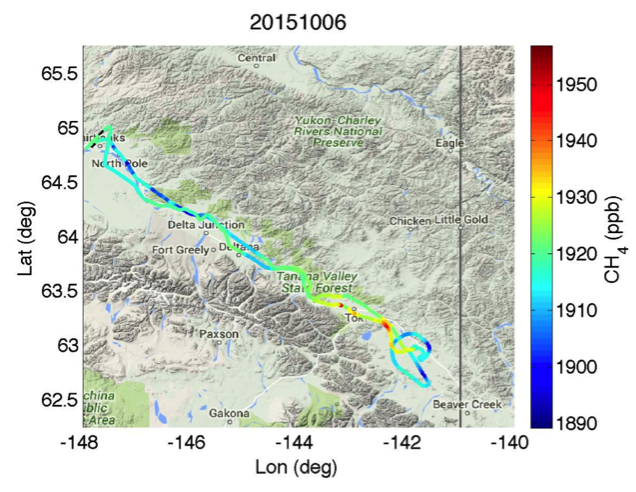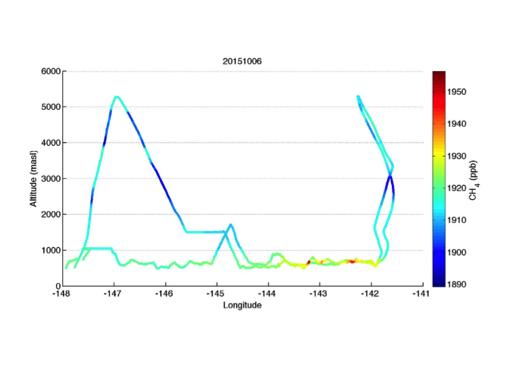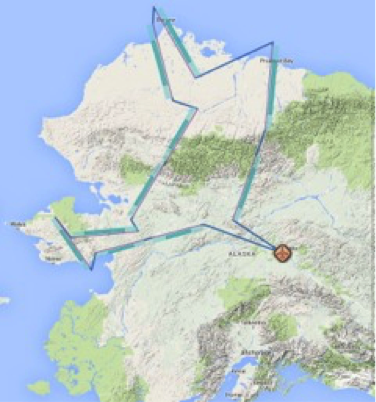AVIRIS-Classic flew the HyspIRI Airborne Campaign Yosemite Box on Tuesday, October 20. This is the last season of the HyspIRI Airborne campaign in California.
You are here
News
CARVE last week, flew 26 science flight hours, in four flight days. CARVE flew to Fort Yukon Bethel, Barrow, and Nikolai.
On Saturday, October 17, with inclement weather covering all of Alaska, we concluded the successful October campaign.

CARVE for October, flew a total of 54 science flight hours in 10 flight days.
Late last week, OMG received the very first quick look preliminary data from the Cape Race cruise this summer. This data will be loaded on the OMG data server, and will be available to the OMG science team and public.
The L-band radar aboard the JSC G-III aircraft successfully completed four local California flights in support of Sacramento Levee monitoring and San Andreas Fault monitoring flight requests. The radar and the aircraft’s Precision Platform Autopilot (PPA) system both performed very well and the radar was off-loaded at Armstrong’s Palmdale facility before the JSC G-III returned to Texas for annual maintenance and astronaut return mission.
Back at JPL, we’ve had a chance to process the sea ice data acquired on October 6 for lead investigator Ben Holt, who is surveying Beaufort sea ice with his colleagues onboard the National Science Foundation Research Vessel Sikuliaq operated by the University of Alaska Fairbanks School of Fisheries and Ocean Sciences. We were able to locate the ice breaker in the UAVSAR image and sent the geolocated data to the researchers onboard the ship via satellite communication link. They will be using UAVSAR data together with satellite SAR imagery to navigate the fresh ice in Beaufort Sea to study the utility of SAR remote sensing to identify young ice types.Attached is a quick look polarimetric color overlay image of the ice field surrounding the ice breaker, which was parked in a narrow crack of multi-year ice. Visible in the SAR image is the frozen over ship track as the ship traveled north up the narrow crack.

The ASO team is back to surveying in Northern CA. This weekend the flight team took advantage of the lull of Columbus Day Weekend and completed a large survey in a difficult to access airspace over Kings Canyon National Park.
AVIRIS-Classic flew the HyspIRI Airborne Campaign Tahoe Box on Tuesday (October 13). The last season of the planned HyspIRI campaign is in the final weeks. There are 2 more boxes, So CA and Yosemite that will be flown in the next 2 weeks.
CARVE last week flew 6 science flight days, for a total of 27 science flight hours. CARVE flew to Innoko, Bethel, Nikolai, and Fort Yukon (twice) and down towards Beaver Creek.
Ch4 track plots below shows increased CH4 near Delta junction and just South of Tok.


Permafrost observation was conducted on Monday Oct. 5. This was accomplished by swapping the radar pods back at Palmdale last Friday and conducting an engineering/calibration flight on Saturday to certify the L-band radar aboard NASA992.
While in Alaska with the L-band radar, we were able to add an opportunistic observation of sea ice in Beaufort Sea (PI: Ben Holt) in coordination with the National Science Foundation Research Vessel Sikuliaq operated by the University of Alaska Fairbanks School of Fisheries and Ocean Sciences. The objective of the flight is to utilize UAVSAR’s high system sensitivity to study young ice types within a backscatter range unavailable from space borne systems.
Upon completion of the P-band radar observations of root zone soil moisture (RZSM) for the AirMOSS mission, the P-band radar aboard the JSC G-III transited to Fairbanks to observe RZSM in the permafrost region as part of an Interdisciplinary Science task led by Dr. Mahta Moghaddam of USC. The Fairbanks local flight consisted of ten flight lines (see map) that provided a sampling of the landscape north and west of Fairbanks. Several of the flight lines covered boreholes operated by University of Alaska, which will enable scientists to correlate radar observations to borehole observations. This flight will be repeated in April 2016 to complete two years of 3 observations each to study seasonal variability in the RZSM of permafrost region.

The HyspIRI Preparatory Campaign had a successful flight on 10/2/15 over San Francisco Bay box.
